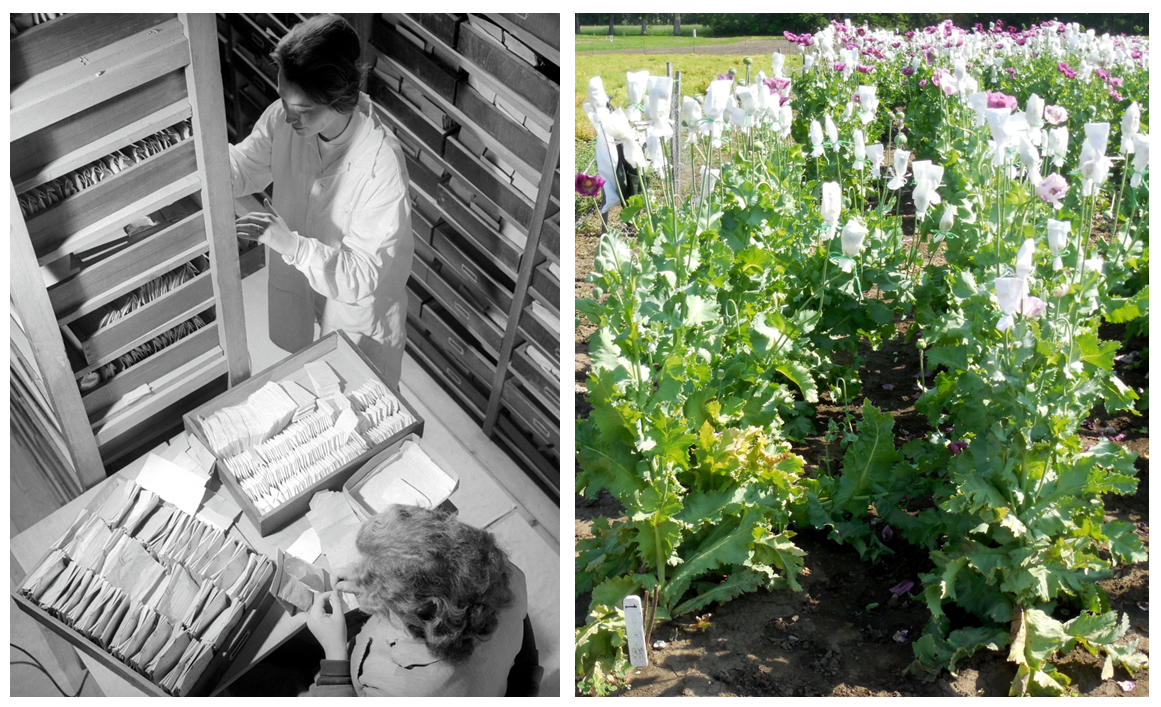History and current status of plant genetic resources conserved and maintained by the Hungarian central genebank
Main Article Content
Abstract
The predecessor of the National Centre for Biodiversity and Gene Conservation (NBGK) was established in Hungary in 1959. The 1950s were hectic times for Hungarian plant breeders, and many new genetic materials were registered in the National List of Varieties. In order to save obsolete genetic resources, in 1959 the government founded the Agrobotanical Institute at Tápiószele to prevent plant genetic erosion in the Pannonian region. The centre started its operation with 16,596 accessions. Their quantity continuously increased thanks to collecting missions and international connections. The NBGK collection is composed of cereals (37.3%), vegetables (18.7%), legumes (17.4%), industrial crops (5.29%), fruits and grapes (3.85%) and others. NBGK has operated under its current name since 2019 with the same mission as when it was first established. Today, it is the seventh largest genebank in Europe with 57,381 accessions of 1,745 plant species across 605 genera. Almost 95% of samples are maintained in the form of seeds in 15 cooled storage rooms (at temperatures of 5–8°C or -18°C), while the others are conserved in vitro, in the form of tubers or field collections. Sharing genetic materials has been a crucial part of the institute’s activities since the beginning. Between 2019 and 2023, a total of 92,100 samples were distributed to a variety of partners, mainly gardeners and farmers (83.85%) and NGOs (14.63%). Researchers, breeders and universities account for only 1.52% of seed requests, which is the opposite of what is observed in other genebanks.
Article Details

This work is licensed under a Creative Commons Attribution 4.0 International License.
Authors retain copyright of the articles published in Genetic Resources and grant the journal right of first publication with open access. All articles published in Genetic Resource are licensed under Creative Commons Attribution 4.0 International License (CC BY 4.0) that allows others to download, share and adapt the work for commercial and non-commercial purposes as long as proper attribution to the original article is given. Genetic Resources permits and encourages authors to post items submitted to the journal (including the publisher's final layout) on personal websites or institutional repositories after acceptance and/or publication, while providing bibliographic details that credit their publication in Genetic Resources.
Correa, C M (2006). “Considerations on the Standard Material Transfer Agreement under the FAO Treaty on plant genetic resources for food and agriculture”. The Journal of World Intellectual Property. DOI: https://doi.org/10.1111/j.1422-2213.2006.00272.x. DOI: https://doi.org/10.1111/j.1422-2213.2006.00272.x
Cromarty, A S, R H Ellis, and E H Roberts (1982). Design of seed storage facilities for genetic conservation. Handbooks for genebanks n.1. Rome: International Board for Plant Genetic Resources. URL: https://hdl.handle.net/10568/104304.
Dickie, J B et al. (1990). “Temperature and seed storage longevity”. Annals of Botany 65, pp. 197–204. DOI: https://doi.org/10.1093/oxfordjournals.aob.a087924
Engelmann, F (2011). “Use of biotechnologies for the conservation of plant biodiversity”. In Vitro Cellular and Developmental Biology - Plant 47, pp. 5–16. DOI: https://doi.org/10.1007/s11627-010-9327-2. DOI: https://doi.org/10.1007/s11627-010-9327-2
FAO (2014). Genebank Standards for plant genetic resources for food and agriculture. URL: https://www.fao.org/4/i3704e/i3704e.pdf.
Guerrant, E. O., Havens, K., Vitt, P., and Herendeen, P. S. (2014). Sampling for effective ex situ plant conservation. International Journal of Plant Sciences 175(1), 11–20. doi: https://doi.org/10.1086/67413 DOI: https://doi.org/10.1086/674131
Gyurkó, A et al. (2023). “Complex evaluation of wild pear”. Acta Universitatis Sapientiae – Agriculture and Environment, 15, pp. 66–73. DOI: https://doi.org/10.2478/ausae-2023-0006
Hannin, D, J M Codron, and D Thoyer (2006). “The International Office of Vine and wine (OIV) and the World Trade Organization (WTO): Standardization Issues In The Wine Sector”. In: Agricultural Standards. LEAF. Ed. by J Bingen and L Bush. Vol. 6. doi: https://doi.org/10.1007/1-4020-3984-0_4. Dordrecht: Springer. DOI: https://doi.org/10.1007/1-4020-3984-0_4
Hay, F R and R J Probert (2013). “Advances in seed conservation of wild plant species: a review of recent research”. Conservation Physiology 1, pp. 1–11. DOI: https://doi.org/10.1093/conphys/cot030. DOI: https://doi.org/10.1093/conphys/cot030
Holly, L et al. (2009). “Inventorying and on-farm maintenance of Hungarian landraces”. In: European landraces on-farm conservation, management and use. Ed. by M Veteläinen, V Negri, and N Maxted. Bioversity Technical Bulletin No. 15. url: https://hdl.handle.net/10568/106154. Rome: Bioversity International.
Jánossy, A (1971). “Ten years of the National Institute of Agrobotany (1959-1969)”. Agrobotanika 11, pp. 21–21.
Jánossy, A and F G H Lupton (1974). “Heterosis in plant breeding”. In: Proceedings of the 7th Congress of EUCARPIA.
Kis, P et al. (2023). “Comparison of RAPD and SSR molecular marker methods for classification of khorasan wheat genebank accessions”. In: Book of abstracts, 7th Conference on Cereal Biotechnology and Breeding, Wernigerode, Germany, pp. 84–84.
Nagel, M and A Börner (2010). “The longevity of crop seeds stored under ambient conditions”. Seedscience Research 20, pp. 1–12. DOI: https://doi.org/10.1017/S0960258509990213
Röder, M S et al. (1998). “A microsatellite map of wheat”. Genetics 149(4), pp. 2007–2023. DOI: https://doi.org/10.1093/genetics/149.4.2007
Thormann, I, J M M Engels, and M Halewood (2018). “Are the old International Board for Plant Genetic Resources (IBPGR) base collections available through the Plant Treaty’s multilateral system of access and benefit sharing? A Review”. Genetic Resources and Crop Evolution 66, pp. 291–310. DOI: https://doi.org/10.1007/s10722-018-0715-5. DOI: https://doi.org/10.1007/s10722-018-0715-5
UPOV (2005). Guidelines For The Conduct Of Tests For Distinctness, Uniformity And Stability – TG/14/9Apple. URL: https://www.upov.int/en/publications/tg-rom/tg014/tg_14_9.pdf.
Walters, C, C M Richards, and G M Volk (2018). “Genebank conservation of germplasm collected from wild species”. In: North American Crop Wild Relatives. Ed. by S Greene et al. Vol. 1, pp. 245–280. DOI: https://doi.org/10.1007/978-3-319-95101-0_10







 This journal has been conceived as part of the
This journal has been conceived as part of the